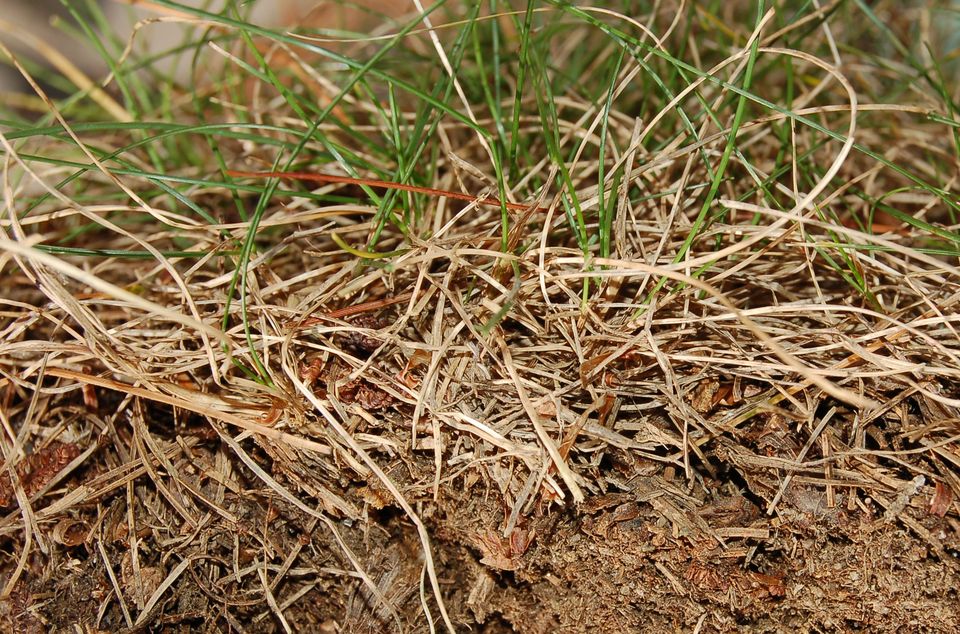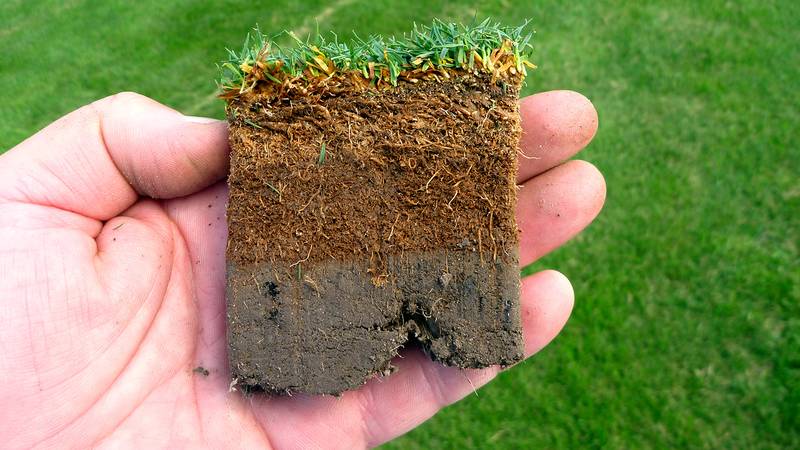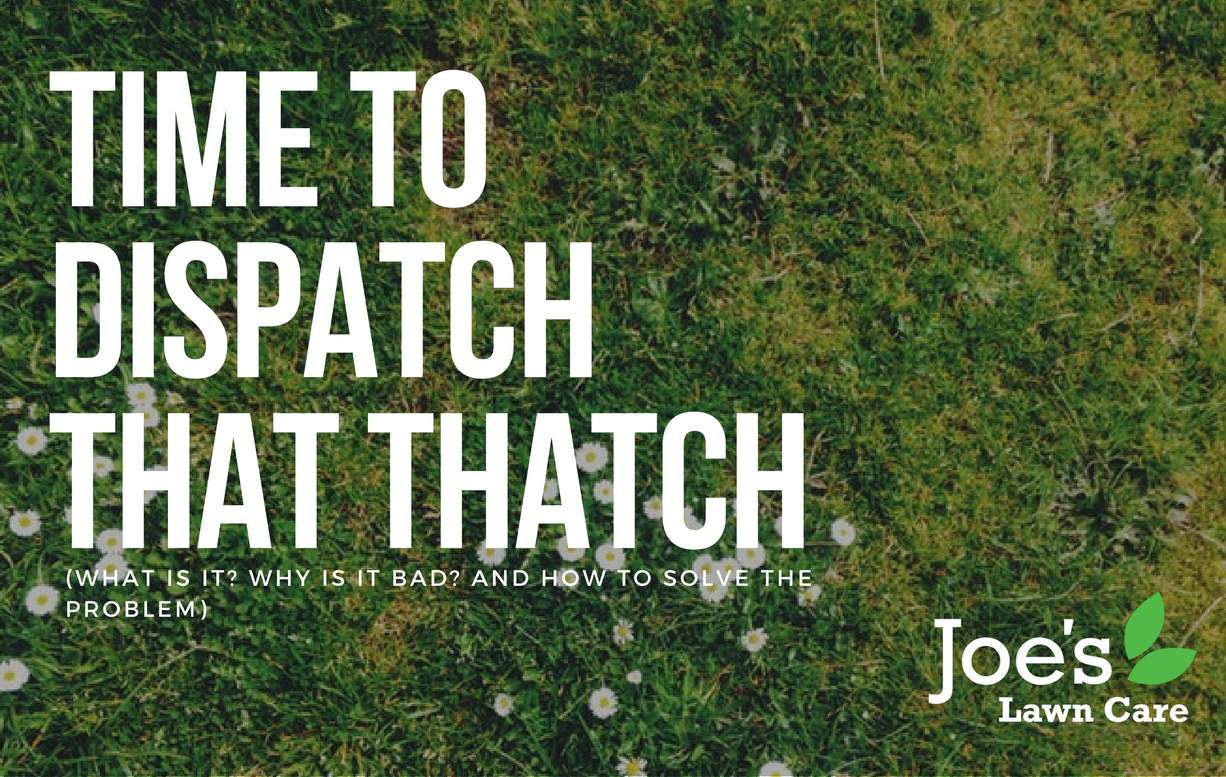If we’re going to be honest (and, at Joe’s Lawn Care, we pride ourselves on our honesty), we wanted to start with a pun about Margaret Thatcher, but we decided it was probably best to adhere conversational etiquette for once and avoid politics at all cost. It just isn’t worth losing friends over.
What we’re going to do instead is just jump straight into the deep end and tell you a) what this blasted lawn thatch is, b) why it’s so bad for your turf, c) what may have caused it to revolt in the first place and d) how you can get all medieval on it, banishing it from your castle grounds faster than you can say, “I broke my chopsticks”.

So, What The Heck Is Lawn Thatch?
For those that have never thumbed through a dictionary on a Saturday night because of a power cut and there being nothing else to do, lawn thatch is a horrid mess of part-living and mainly-dead plant matter that lays between the green grass you love admiring from your kitchen window, the root systems you can’t really see and the soil from whence your grass came (apologies for ye olde English there, it just seemed right).
Some of the time, thatch is fine. It’s not ideal, but it’s fine. If, however, any thatch gets so thick it crosses the half an inch mark, then it’s going to start wrecking your lawn faster than Donald Trump is wrecking the world, which is why you need to pull your socks up, your boots on and make sure it is removed, pronto. It’s the only surefire way to make sure your lawn stays healthy. Oddly enough, this process is called – wait for it – ‘dethatching’. Genius, huh.
What Do We Mean By ‘A Mess Of Plant Matter’?
More often than not, lawn thatch is a knotty cocktail of organic matter; things like crowns, stolons, rhizomes, stems and roots that haven’t quite managed to decompose properly, and the reason they haven’t decomposed like your grass blades is because they are more stubborn than Thatcher herself (#sorry #politics).

Why Are We So Worried About Thatch?
The moment lawn thatch becomes half an inch thick, it creates a great barrier reef of pain, turmoil and anguish for your lawn. Air can’t get through, water can’t get in and nutrients can’t seep down into the root system, which is what your lawn needs in order to survive and thrive. It’s a nightmare. But the punishment doesn’t end there because the thicker your thatch gets the more chance there is of lawn care problems, such as disease running riot and insects starting to cause infestations.
Rather frustratingly, thatch can start to wreak havoc on your patience too. That’s because your thatch-based problems go beyond your lawns health and can make the arduous chore that is mowing your lawn even more problematic. You see, when a lawn starts to develop patches of thatch, these areas become, how do we say, a little more spongy, and when you hit these spongy-potholes with your mower, you’ll find your wheels sink in and you suddenly scalp your lawn in the most blood-boiling way possible.
Basically, thatch can get real nasty if you don’t deal with it.
How Is This Son Of A Thatch Caused?
Here’s the bad news: thatch is one of those things that just starts to form over time and, while there are things you can do to prevent super-thick thatch from developing, there are some things that can actually cause it to get worse. Things like watering your grass excessively and adding lots of fertiliser that’s high in nitrogen can cause your grass to grow abnormally fast, meaning that organic matter we spoke of earlier can’t decompose (read: get out of the way) quick enough.
Another thing that can throw a spanner in the thatch-management works is the excessive use of pesticides. The reason being: pesticides kill earthworms and earthworms are great at helping organic matter decompose, which means thatch won’t build up so fast. So, yeah, stop killing your allies. You need them.
Okay, So What’s The Solution Here?
Now that we have covered thatch’s backstory, there is only one thing left to do and that is get rid of it. How you do this depends on just how bad your thatch problem is, but there are two main options: scarification or aeration.
If you’re looking at a mild case of thatch, then a quick spot of dethatching is all you need. To do this, pop into your shed-slash-garage, find your rake, take a few deep breaths and start raking your thatch away as vigorously as you can. Now, your next-door-neighbour, Keen Kevin, may well have a “scarifying rake” to do the job but, trust us, a normal rake will be up for the challenge, no problems whatsoever. Anyway, we know this whole dethatching thing sounds like a bit of a chore, and it is, but if you time it well then you can actually kill two to three birds with one stone. Let’s use autumn as a prime example: you can rake up all those leaves, add them to your compost pile and remove your lawn thatch all at once.
If, however, you’re staring you down the barrel of a pretty severe thatch problem, then your best bet is called “core aeration”. How you do this is up to you. You could do it the more archaic way, which involves stabbing your lawn over and over and over again with a pitchfork, or you could do it the more effective way, which involves using a lawn aeration machine. Personally, we wouldn’t recommend buying one of these machines because, well, you won’t need to use it all that often. Instead, we recommend you rent one from your nearest tool hire shop or, better yet, call the professionals in to perform this task for you.
And there we have it, the solution to all your thatch problems.





